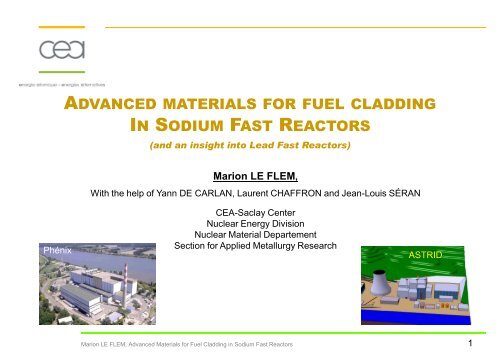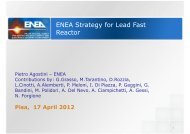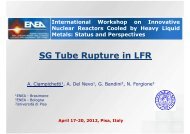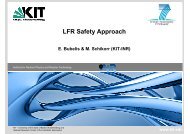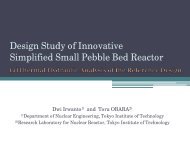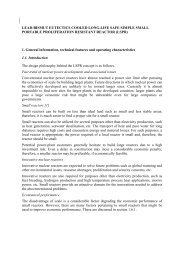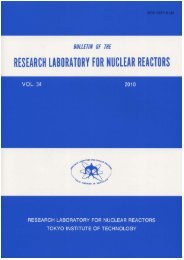advanced materials for fuel cladding in sodium fast reactors in ...
advanced materials for fuel cladding in sodium fast reactors in ...
advanced materials for fuel cladding in sodium fast reactors in ...
You also want an ePaper? Increase the reach of your titles
YUMPU automatically turns print PDFs into web optimized ePapers that Google loves.
ADVANCED MATERIALS FOR FUEL CLADDINGIN SODIUM FAST REACTORS(and an <strong>in</strong>sight <strong>in</strong>to Lead Fast Reactors)Marion LE FLEM,With the help of Yann DE CARLAN, Laurent CHAFFRON and Jean-Louis SÉRANPhénixCEA-Saclay CenterNuclear Energy DivisionNuclear Material DepartementSection <strong>for</strong> Applied Metallurgy ResearchASTRIDMarion LE FLEM, Advanced Materials <strong>for</strong> Fuel Cladd<strong>in</strong>g <strong>in</strong> Sodium Fast Reactors 1
Introduction – SFRIn-service condition <strong>for</strong> the <strong>cladd<strong>in</strong>g</strong> material• Temperature : 400°C-650°C (700°C)• Ultimate target dose : up to 180-200 dpa~ Comparable to LFR but dose (400-550°°C, C, 100dpa)Ma<strong>in</strong> functions of the p<strong>in</strong> (critical component)• Welcom<strong>in</strong>g MOX <strong>fuel</strong> (conf<strong>in</strong>ement of <strong>fuel</strong> and fission products)• Provid<strong>in</strong>g heat exhange between <strong>fuel</strong> and NaSodium-Cooled Fast ReactorRequired properties• Compatibility with Na and with <strong>fuel</strong> (k<strong>in</strong>etics) + reprocess<strong>in</strong>g• Compatibility with rapid neutron spectrum (activation, transparency)• Mechanical <strong>in</strong>tegrity <strong>in</strong> any condition (<strong>cladd<strong>in</strong>g</strong> = 1st barrier of conf<strong>in</strong>ement) Appropriate mech. strength, ductility (>0,2%), toughness (>20 MPa.m 1/2 ) Good dimensional stability (clad diameter, elongation) Resistance to irradiation swell<strong>in</strong>g (
Introduction – SFR Fuel <strong>cladd<strong>in</strong>g</strong>Reference Materials <strong>for</strong> SFR = steelsAustenitic steels 15/15 TiSwell<strong>in</strong>g must be decreased• Appropriate mechanical properties and also <strong>for</strong> LFR• But swell<strong>in</strong>g worries result<strong>in</strong>g <strong>in</strong> embrittlement Incubation time and life time restriction to dose lower than 130dpaFerritic steels (9-12%Cr, T91, EM10)• OK <strong>in</strong> SFR as wrapper tube and also <strong>in</strong> LFR• Too weak <strong>for</strong> SFR <strong>cladd<strong>in</strong>g</strong>Mechanical properties must be enhancedBe<strong>for</strong>e irradiationPhénixSwell<strong>in</strong>gEmbrittlement limit15/15 TiAfter irradiation130dpa maxFerritic-martensitic steelsRapsodieMarion LE FLEM, Advanced Materials <strong>for</strong> Fuel Cladd<strong>in</strong>g <strong>in</strong> Sodium Fast Reactors 3
Introduction – SFR Fuel <strong>cladd<strong>in</strong>g</strong>Low swell<strong>in</strong>g and appropriate mechanical properties Advanced <strong>materials</strong> <strong>for</strong> SFR1- Advanced austenitic steels2- Ferritic/martensitic ODS Steels (Oxide dispersed strengthen<strong>in</strong>g)3- Refractory metals4- Ceramics ?Melt<strong>in</strong>g temperature ↗Innovation ↗And <strong>for</strong> LFR ?• Ma<strong>in</strong> drawback is compatibility with Pb need of coat<strong>in</strong>gs or new alloys Also need of <strong>materials</strong> with higher per<strong>for</strong>mances (cfSFR)Marion LE FLEM, Advanced Materials <strong>for</strong> Fuel Cladd<strong>in</strong>g <strong>in</strong> Sodium Fast Reactors 4
1- Advanced Austenitic Steels (1/3)Improvement of resistance to swell<strong>in</strong>g= Comb<strong>in</strong>ation of benefic parameters- High Ni content 15-30% <strong>in</strong>hibitor <strong>in</strong> solid solution- Stabilisation by Ti (even by Ti + Nb + V) + cold work (25% CW) carbide precipitation- Use of Si + P enhancement of precipitation under irradiationSSmall level of CW cavities <strong>in</strong> the cells15/15Ti ,100dpa, 560°C20% CW Dislocations p<strong>in</strong>ned by TiCBenefic effect of Ni(swell<strong>in</strong>g <strong>in</strong>hibitors <strong>in</strong> solid solution)Narrow specifications to fulfil the requirements…Impact on chemical composition, homogeneity, process…Marion LE FLEM, Advanced Materials <strong>for</strong> Fuel Cladd<strong>in</strong>g <strong>in</strong> Sodium Fast Reactors5
1- Advanced Austenitic Steels (2/3)Mechanical properties – Out of pile propertiesTensile testsYield Stress (MPa)[CEA]Ti+Nb+V stabilized700Ti+Nb stabilized[CEA]600500Ti stabilized400300m<strong>in</strong>imum of 15/15 Ti20 200 400 500 600 700Test temperature (°C)• Advanced austenitic steels exhibit comparableproperties to 15/15Ti• To be determ<strong>in</strong>ed after irradiation…Marion LE FLEM, Advanced Materials <strong>for</strong> Fuel Cladd<strong>in</strong>g <strong>in</strong> Sodium Fast Reactors 6
1- Advanced Austenitic Steels (3/3)Swell<strong>in</strong>g resistance – Supernova experience <strong>in</strong> Phénix (1988-2005 89dpa)Confirmation of improvement <strong>in</strong> swell<strong>in</strong>g resistance via Ti+Nb stabilization ofaustenitic steels[CEA]normalized flux10.9Volume swell<strong>in</strong>g (%)Reference15/15 T<strong>in</strong>on-optimized 15/15 TiAdvanced austeniticTi stabilized0.80.70.60.50.40.30.2• Possible optimisationof 15/15 Ti• Stability to be provedabove 150dpa0.10Advanced austeniticTi+Nb stabilizedIrradiation temperature (°C)Marion LE FLEM, Advanced Materials <strong>for</strong> Fuel Cladd<strong>in</strong>g <strong>in</strong> Sodium Fast Reactors 7
2- ODS Steels (1/6)Introduction – Low swell<strong>in</strong>g of ferritic/martensitic steelsBut need of improvement <strong>in</strong> mechanical properties (creep)ε (%)Pr<strong>in</strong>ciple of ODS (Oxide Dispersed Strengthen<strong>in</strong>g) :Re<strong>in</strong><strong>for</strong>cement of ferritic/martensitic steels by homogeneous distribution of nanosize oxides(e.g. Y 2 O 3 ), stable <strong>in</strong> temperature and under irradiationFerritic Fe 14Cr 1W 0,3Mn 0,3 Si 0,2 Ni Ti + Y 2 O 3Fe-18Cr650°C180 MPaODS Fe-18Cr 0,5 Y 2 O 3Time (h) Fe 18Cr 1W 0,3Mn 0,3 Si 0,2 Ni Ti + Y 2 O 3 Fe 14Cr 2W Ti + Y 2 O 3- Anisotropic- Possible embrittlement under irradiation- Recrystallization difficult to control- Good corrosion resistanceMartensiticODS:Low de<strong>for</strong>mation +Increase <strong>in</strong> rupture timetime Fe 9Cr 1W 0,3Mn 0,3 Si 0,2 Ni Ti + Y 2 O 3 Fe 9Cr 2W 0,3Mn 0,3 Si 0,2 Ni Ti + Y 2 O 3- Isotropic- Easier to manufacture- T < 750°C- Questionnable corrosion resistanceMarion LE FLEM, Advanced Materials <strong>for</strong> Fuel Cladd<strong>in</strong>g <strong>in</strong> Sodium Fast Reactors8
2- ODS Steels (2/6)Fabrication – Powder metallurgy (≠ melt<strong>in</strong>g of basic steels)Broyage mécaniqueMechanical alloy<strong>in</strong>gGa<strong>in</strong>ageCann<strong>in</strong>gHot extrusionFilage à chaudAlloyed Poudre pré-alliée powderpowder PoudreYPoudre Y 2 O 2 O 3 powder 3Matériau extruded f<strong>in</strong>al steelBars, tubesCEA/ SRMA/LTMEXMarion LE FLEM, Advanced Materials <strong>for</strong> Fuel Cladd<strong>in</strong>g <strong>in</strong> Sodium Fast Reactors 9
2- ODS Steels (3/6)Microstructure – What happens dur<strong>in</strong>g fabrication ?Be<strong>for</strong>e MAFe-9/18Cr-Ti (Ø = 100 µm)10 % Y 2 O 3 (Ø = 1 µm)After MA100 µm200 µmFe crystallite (15 nm)Amorphousphases(10 nm)Fe crystallite(100 nm or more withnano YTiO particles)(Y, Ti, O)Y 2 Ti 2 O 7YTiO 310 nmAfter MA + Anneal<strong>in</strong>g100 µmMarion LE FLEM, Advanced Materials <strong>for</strong> Fuel Cladd<strong>in</strong>g <strong>in</strong> Sodium Fast Reactors[M. Ratti, thèse CEA 2009]10
2- ODS Steels (4/6)Mechanical properties – Tensile testsODS 14Cr steel0,3 Y 2 0 325201210Energy (J)151058642000 200 400 600 800 -150 -100 -50 0 50 100 150 200 250 300 350Temperature (°C)Temperature (°C)• Anisotropy• Ductility depends on orientation, and object• Influence of fabrication routeMarion LE FLEM, Advanced Materials <strong>for</strong> Fuel Cladd<strong>in</strong>g <strong>in</strong> Sodium Fast Reactors 11
2- ODS Steels (5/6)Mechanical properties – Creep resistance650°CMA 957250 MPaCEA 14 Cr ODSCEA 18 Cr ODS250 MPa300 MPa• MA ODS >> conventionnal Ferritic/Martensitic steels (EM12)• Austenitic 15/15Ti rema<strong>in</strong>s better than ODS BUT could be comparable <strong>for</strong> long time• Low <strong>in</strong>tragranular de<strong>for</strong>mation of ODS large secondary creep doma<strong>in</strong> BUT no tertiary creep doma<strong>in</strong>•Need to understand de<strong>for</strong>mation and damage occurrence (failure) dislocation/precipitates <strong>in</strong>teractionMarion LE FLEM, Advanced Materials <strong>for</strong> Fuel Cladd<strong>in</strong>g <strong>in</strong> Sodium Fast Reactors 12
2- ODS Steels (6/6)Stability under irradiationMechanical properties (on grade DY = prelim<strong>in</strong>ary ODS grade Fe13 Cr2Ti1,5 Mo + 0,5 Y 2 O 3 -TiO 2 )4 Elong. (%)3unirr.Be<strong>for</strong>e irradiation484°C - 76 dpa21UE = TE0-300 0 300 600 900RuptureDuctile "Cleavage"DuctilePresent grades (e.g. developed at CEA) stableLarge (Y,Ti) 2 O 3 – Ø > 10-100 nm• Occurrence of damage with dose but rema<strong>in</strong> crystall<strong>in</strong>e• Slight dissolution under irradiationNano-sized (Y,Ti,O) oxides – Ø < 10 nm• No obvious evolution <strong>in</strong> size… High embrittlement…Need of optimized gradesand dedicated R&D programup to 45 dpa at 500°C(<strong>in</strong> situ TEM)[Lescoat JNM 2011]Fe18Cr1W0.4Ti + 0.6 Y 2 O 3Marion LE FLEM, Advanced Materials <strong>for</strong> Fuel Cladd<strong>in</strong>g <strong>in</strong> Sodium Fast Reactors 13
ODS = present reference <strong>for</strong> future evolution ofASTRID core (SFR prototype).First Cores ASTRIDAIM1 (15-15 Ti)One ODS sub assemblyASTRID prototypeOther <strong>in</strong>novations are under <strong>in</strong>vestigation <strong>in</strong>particular <strong>in</strong> terms of marg<strong>in</strong> to melt<strong>in</strong>g and stabilityof the core <strong>in</strong> case of accidental scenario (high T°C) Refractory <strong>materials</strong> (Metals ? Ceramics ?)Marion LE FLEM, Advanced Materials <strong>for</strong> Fuel Cladd<strong>in</strong>g <strong>in</strong> Sodium Fast Reactors 14
3- Refractory metals (1/7)IntroductionV• Nb, Mo, Ta and W are not acceptable <strong>in</strong> terms of neutron compatibility (absorption…)• Only semi-refractory V, Cr and Zr exhibit enough neutron transparency• Only V exhibits• appropriate strength at high temperature• AND widely known behavior under irradiationIs vanadium a good candidate<strong>for</strong> SFR <strong>fuel</strong> <strong>cladd<strong>in</strong>g</strong> ?Marion LE FLEM, Advanced Materials <strong>for</strong> Fuel Cladd<strong>in</strong>g <strong>in</strong> Sodium Fast Reactors 15
3- Refractory metals – Vanadium alloys (2/7)V-4Cr-4Ti = reference gradeMost of the <strong>in</strong>vestigations were per<strong>for</strong>med on the V-Cr-Ti system (fusion application)• Cr <strong>in</strong> solid solution <strong>in</strong>creases hardness and mechanical properties• Ti <strong>in</strong> solid solution allows ductility and limits irradiation swell<strong>in</strong>g[Smith 1995]V-4Cr-4TiV-4Cr-4Ti• Occurrence of maximum swell<strong>in</strong>g with dose• Swell<strong>in</strong>g <strong>in</strong>crese with Cr%• Very low swell<strong>in</strong>g of V-4Cr-4Ti optimized gradeMarion LE FLEM, Advanced Materials <strong>for</strong> Fuel Cladd<strong>in</strong>g <strong>in</strong> Sodium Fast Reactors
3- Refractory metals – Vanadium alloys (3/7)Mechanical properties[Smith 2000]• V-4Cr-4Ti exhibits stable UTS up to 700-750°C• Comparable to 15/15Ti at 600°C• Prelim<strong>in</strong>ary calculations suggest V-4Cr-4Ti is OK <strong>for</strong> SFR <strong>cladd<strong>in</strong>g</strong>• ODS steels are stronger BUT…… effect of Cr on creep resistance V-15Cr-5Ti ~ ODS steelsMarion LE FLEM, Advanced Materials <strong>for</strong> Fuel Cladd<strong>in</strong>g <strong>in</strong> Sodium Fast Reactors 17
3- Refractory metals – Vanadium alloys (4/7)Mechanical properties : V is ductile ![Chung 1996] [Gentzbittel 2012]DBTT = -200°C• low DBTT (-200°C) compared to ODS steels (~-100°C at best)• limited primany and secondary creep• ductile behavior (≠ ODS)Marion LE FLEM, Advanced Materials <strong>for</strong> Fuel Cladd<strong>in</strong>g <strong>in</strong> Sodium Fast Reactors 18
3- Refractory metals – Vanadium alloys (5/7)Mechanical properties : V is ductile ! Even after irradiation• Embrittlement at low irradiation temperature but recovery above ~400°C• Basically, total recovery at 0.3×Tm = 650°C• Detrimental effet of O and high Cr (more pronounced embrittlement)Marion LE FLEM, Advanced Materials <strong>for</strong> Fuel Cladd<strong>in</strong>g <strong>in</strong> Sodium Fast Reactors 19
3- Refractory metals – Vanadium alloys (6/7)Keypo<strong>in</strong>t = compatibility with environment…• Diffusion of O <strong>in</strong> the V substrate below theoxide layer embrittlement• Need of cann<strong>in</strong>g dur<strong>in</strong>g fabrication• Need of strong atmosphere control dur<strong>in</strong>g hightemperature tests (creep…)[M. Fujiwara 2002]Need of external protection…Marion LE FLEM, Advanced Materials <strong>for</strong> Fuel Cladd<strong>in</strong>g <strong>in</strong> Sodium Fast Reactors 20
3- Refractory metals – Vanadium alloys (7/7)Need of external protection - example :• V-4Cr-4Ti with silicide coat<strong>in</strong>g at 650°C <strong>in</strong> He + 5ppmO 2∆m/S (mg.cm -2 )6543210V-4Cr-4Ti (GfE)V(Cr)Si 2V(Ti)Si 20 100 200 300 400temps (h) [Chaia 2012]• Very low weight ga<strong>in</strong> <strong>in</strong> air and <strong>in</strong> He + 5 ppm O 2• No dissolution <strong>in</strong> impure liquid NaMarion LE FLEM, Advanced Materials <strong>for</strong> Fuel Cladd<strong>in</strong>g <strong>in</strong> Sodium Fast Reactors21
3- Ceramic <strong>cladd<strong>in</strong>g</strong> ? (1/3)Introduction – Numerous advantages <strong>for</strong> SiC f /SiC• Intr<strong>in</strong>sic properties <strong>for</strong> SiC– Irradiation resistance– Heat resistance, heat transfer– Thermo-chemical stability– Neutron transparency– Low activation• Ma<strong>in</strong> features of SiC/SiC– Non catastrophic failure– Stable mechanical properties up to 1000°C at least– Anisotropic but tailorable properties– Stability under irradiation if appropriate fibersCVI SiC/SiC3 rd generation SiC/SiC(TSA3, Hi-Nicalon S)1 st and 2 nd generation SiC/SiC(Nicalon, Hi-Nicalon)[Jones 2002]CEA, "Science as art " 1st place,MRS Fall meet<strong>in</strong>g 2009Marion LE FLEM, Advanced Materials <strong>for</strong> Fuel Cladd<strong>in</strong>g <strong>in</strong> Sodium Fast Reactors 22
3- Ceramic <strong>cladd<strong>in</strong>g</strong> ? (2/3)Mechanical properties – SiC f /SiC = Elastic damageable materialNon l<strong>in</strong>ear response to thermomechanical sollicitations dependant on the SiCf/SiC (architecture,constituents, type of sollicitation…).3 doma<strong>in</strong>s related to damage occurrence <strong>in</strong> the compositeElestic doma<strong>in</strong>Matrix crack<strong>in</strong>g Fiber ruptureQuestionnable po<strong>in</strong>ts :Damageable elastic material !cracks, change <strong>in</strong> propertiesloss of gas-tighness, design ?CMC are challeng<strong>in</strong>g<strong>materials</strong> <strong>for</strong> nuclearapplicationMatrix crack<strong>in</strong>gTensile Test on a m<strong>in</strong>icomposite[El Yagoubi 2011]Guillaumat, LCTS 1994Marion LE FLEM, Advanced Materials <strong>for</strong> Fuel Cladd<strong>in</strong>g <strong>in</strong> Sodium Fast Reactors 23
3- Ceramic <strong>cladd<strong>in</strong>g</strong> ? (3/4)Matrix crack<strong>in</strong>g – impact on thermal conductivity (key po<strong>in</strong>t)• SiC/SiC exhibit low and scattered conductivity (10 W/m.K max)• It drops with irradiation• It drops with matrix crack<strong>in</strong>g[Hegeman 2005][El Yagoubi 2011]Matrix crack<strong>in</strong>gFiber ruptureat 900Elestic doma<strong>in</strong>~40%irradiationMarion LE FLEM, Advanced Materials <strong>for</strong> Fuel Cladd<strong>in</strong>g <strong>in</strong> Sodium Fast Reactors
3- Ceramic <strong>cladd<strong>in</strong>g</strong> ? (4/4)Matrix crack<strong>in</strong>g – impact on leaktightness• When cracks occur, there is a loss of leak-tighness (fission products) = « leak be<strong>for</strong>e break »• Need of gas-tight systems abble to susta<strong>in</strong> stra<strong>in</strong> <strong>in</strong> operat<strong>in</strong>g conditions CEA sandwich concept with <strong>in</strong>ner metallic l<strong>in</strong>er (CEA Patent)~100µmW<strong>in</strong>ded 2D braid 3D braidHorizontal 3D braid<strong>in</strong>g mach<strong>in</strong>eExamples of SiC braids [CEA]5 mmExamples of sandwich <strong>cladd<strong>in</strong>g</strong> prototypeSiC/SiC + metallic l<strong>in</strong>er + SiC/SiC• Gastightess even when cracked SiC/SiC (OK up to 300 MPa at least !)• Mechanical properties to be assessed (e.g. <strong>in</strong>ner pressure…)• Chemical compatibility beween SiC and l<strong>in</strong>er to be checked (very good prelim<strong>in</strong>ary results with Ta and Nb)Marion LE FLEM, Advanced Materials <strong>for</strong> Fuel Cladd<strong>in</strong>g <strong>in</strong> Sodium Fast Reactors 25
4- Conclusions1- Advanced Austenitic steels☺ • Very good and achievable response to irradiation swell<strong>in</strong>g of 15/15 Ti• Mechanical properties to be confirmed• Need of additional irradiation experiments to high dose (200dpa)CEA new specificationsby the end of 20122- ODS steels☺• Very good resistance to swell<strong>in</strong>g•Complex process<strong>in</strong>g of powder metallurgy•Almost no tertiary creep doma<strong>in</strong>Stability to be assessed <strong>in</strong> Pb…Limited Cr% is the key po<strong>in</strong>t Coat<strong>in</strong>g ?3- Vanadium alloys☺• V-Cr-Ti alloys seem very appropriate ☹• Mechanical properties >700°C• Improvement of alloys <strong>for</strong> SFRs ?3- Ceramic <strong>cladd<strong>in</strong>g</strong> – SiC/SiC : technological challenge☺• Almost no de<strong>for</strong>mation (expansion, swell<strong>in</strong>g)• High temperature strength (>800°C)•Complex and expensive but achievable fabricationProtection <strong>for</strong> chemical compatibility R&D + complex fabricationWrapper <strong>in</strong> SFRCladd<strong>in</strong>g <strong>in</strong> PWR• Gas-tighness solutions Long term R&DMarion LE FLEM, Advanced Materials <strong>for</strong> Fuel Cladd<strong>in</strong>g <strong>in</strong> Sodium Fast Reactors26


